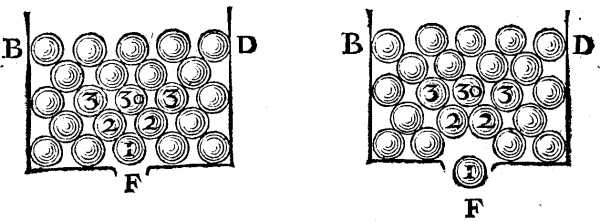How the Air-Aether Makes Things Round
Table of Contents
60. This effort found in the air-aether
The air-aether globules move like:
- The stone in a sling [This is the explosive movement]
- The ball rotating in a tube around the center
E[This is the displacement movement]
Each one tries to move away from the center of the vortex that it revolves around.
They are held in place by other surrounding globules, just as the stone is held by the sling.
- The outer globules are pressed by the inner ones.
All of them together are pressed by fire-aether from the center of each vortex.
To distinguish everything accurately, we will speak here only of these air-aether globules.
We will only speak of the fire-aether when there are spaces that are devoid of the air-aether*.
Superphysics Note
Truly empty space cannot exist.
61. Demonstration on how the Sun and the Fixed Stars are round
All the air-aether globules that revolve around S in Vortex AEI try to move away from S.
- Those in the straight line
SAall press towardsA - Those in the straight line
SEall press towardsEand so on with the rest.

If they are too few to occupy the area between S and the circumference AEI, all that is not occupied is left towards S.
These globules that press on each other in a straight line do not all turn together like a rod.
- Instead, some are quicker than the others in completing their circuit.
The space which they leave near S becomes round.
This makes the space BCD, which they leave around it, round.
62. The same effect causes the air-aether to try to move away from the circumference of any star
All the globules in the straight line SE press one another towards E
- But they are also pressed by those coming from behind them in other angles.
For example, the globule F is pressed by those which are within:
- the lines
BFandDF - the triangular space
BFD
But they are not pressed by the other surrounding air-aether.
If the place F were empty, only the globules contained in the space BFD would fill it up.
63. The air-aether globules do not impede each other in this effort.
Let vessel BFD contain lead balls.
These press against each other in such a way that if a hole is made at the bottom of the vessel at F, ball 1 descends by its own weight.

Balls 2 and 2 will follow it, followed by balls 3, 3, 3, and so on.
Thus when ball 1 leaves, all the others in the triangular space BFD will fall together, leaving the rest immobile. This is becase they will be impeded by globes 2, 2.
However, the same does not apply to the air-aether globules. This is because they are in perpetual motion.
This pause can only last for a minimal moment of time, called an instant.
- This does not interrupt the continuity of their motion.*
Superphysics Note
The force of light does not consist in continuous motion. It is solely from the initial pressure that causes the motion.
64. All the properties of light found is in this effort.
This is why light can be seen as emanating from stars, even if there is no force in the stars themselves.
The action called light spreads equally in all directions from the body of the Sun or any fixed star.
It extends to any distance in the smallest moment of time, along straight lines drawn:
- from the center of the luminous body
- from any other points on its surface.
Hence, all other properties of light can be deduced.
All these things are from the air-aether and not from the star.
If the sun’s body became merely an empty space, its light would be weaker. Yet we would still see it as a circle that moves in the heavens.
This is because we have not yet considered all the dimensions of the solar system*.